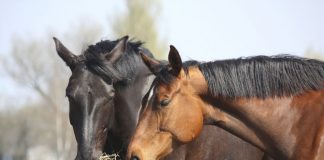Much has been made about all the extras and the precise care the barefoot horse needs. Some of this advice is valid, but some of it should be carefully considered. Here’s what the experts have to say:
Hoof Boots:
Read more about using hoof boots >>
Hoof Hardening Products:
“For an otherwise healthy hoof that has a thin or tender sole, application of a hardener—occasionally—should be safe,” Dr. Lancaster says. “If the feet are cracked or have stretched white lines, owners should be cautious because some of these (particularly if they contain formalin or mercury compounds) could damage sensitive tissue. Research has shown that weak horn is more permeable than normal horn.”

Living Environment:
Generally speaking, horses’ hooves will mirror the environment that they live in. “I don’t have any clients that keep horses in stalls all of the time,” Dr. Lancaster says. “Many of the horses I work on live in stalls half of the time, getting turned out either all day or all night. This gives the feet a chance to be on variable terrain, and most of the horses are able to work barefoot on different terrain. I suppose for a show horse that lives inside all day except for an hour or so of riding might still be OK barefoot if the work is in an arena with soft, even footing.”
Hoof Angles:
Dr. Lancaster says the angles on most healthy front feet tend to fall between 50 and 55 degrees, with the hind feet being approximately 2 degrees steeper. “But horses have differences in conformation that dictate angle differences,” she says. “There are also performance requirements that influence angles. As with any statistical range, there are normal horses that fall outside of this range.”
Certified farrier Walt Taylor, of Albuquerque, N.M., also cautions against getting hung up on hoof angles. “As long as the hoof-pastern axis is right, it doesn’t matter what the numbers are,” he says. “Problems with tying to a number are myriad, not the least of which is the owner who wants to extrapolate that number to every horse.”
“No scientific study supports or refutes any particular method of hoof care,” Dr. Lancaster concludes. “Farriers and veterinarians should be familiar with the range of options and be able to present these to the client so that decisions are made with true informed consent. Owners must be willing to revise treatment plans if the horse does not appear to respond well.”
Back to The Barefoot Life.






I noticed the “experts” in the barefoot article were all people who shoed horses for a living! I think you should have had input from a barefoot expert. My horse has been barefoot all his 15 yrs of life with little to no problems. 2 abcesses in 8 yrs. I feel the article was bias to shoeing. The last thing I would do is put shoes on my horse and it’s the first thing they ususally take off if the horse has a hoof issue! Ask the experts.
I have to agree with Cathie. The writers of this article all rely on shoes. Maybe most of their clients have stalled horses.
My horses live in a herd environment on a small pasture. They have been barefoot trimmed for about 6 years. Three have never worn shoes. The fourth is 27, and wore shoes 9 months of the year until 6 years ago. The benefit to her is amazing.
The old mare did not seem to be a good candidate for going barefoot. Her hoof walls were paper thin, heels flared on hinds, thrushy and ouchy after shoeing and when unshod. But the barefoot trim is different. At 27, she is barefoot sound on all surfaces. Her hoof walls have thickened, and her frogs developed, and her heel flares are barely noticeable. She is in great condition, and still enjoys being ridden.
The “reason” for shoeing is given in this article as “wall wears too fast.” This makes the assumption that the horse’s weight should be supported on the rim of the foot, the hoof wall. After all, the wall is the hardest part of the foot, right? Yes, it is the hardest part, but that doesn’t mean that it should be the supporting structure.
Barefoot horses don’t rely on long hoof walls to keep delicate frogs and soles suspended. On the contrary, the hoof walls need to be short enough so that the flexing sole and frog will contact the ground and develop thick callouses (similar to how a barefoot person develops callouses from friction against the ground). This distributes the horse’s weight over a greater surface area, and reduces the concussion.
The barefoot trimmer may “clean” the sole and remove overgrown bar, but the callouses are retained without thinning.
See Pete Ramey’s book “Making Natural Hoof Care Work For You” for an interesting account of a draft horse that works on concrete all day. Going barefoot has been a benefit to this horse, with the concussive forces dissipated in the soft tissues, rather than being transferred by a steel shoe. He is noticeably less tired at the end of the day now that he is barefoot.
If you want to condition your horse to barefoot soundness, you might want to consider looking for a barefoot trimmer that has a good reputation. There are as many good trimmers as there are good farriers, and as many bad ones, too. Check references!